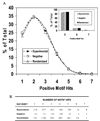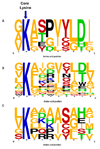Mining the TRAF6/p62 interactome for a selective ubiquitination motif
- PMID: 21554762
- PMCID: PMC3090762
- DOI: 10.1186/1753-6561-5-S2-S4
Mining the TRAF6/p62 interactome for a selective ubiquitination motif
Abstract
A new approach is described here to predict ubiquitinated substrates of the E3 ubiquitin ligase, TRAF6, which takes into account its interaction with the scaffold protein SQSTM1/p62. A novel TRAF6 ubiquitination motif defined as [-(hydrophobic)-k-(hydrophobic)-x-x-(hydrophobic)- (polar)-(hydrophobic)-(polar)-(hydrophobic)] was identified and used to screen the TRAF6/p62 interactome composed of 155 proteins, that were either TRAF6 or p62 interactors, or a negative dataset, composed of 54 proteins with no known association to either TRAF6 or p62. NRIF (K19), TrkA (K485), TrkB (K811), TrkC (K602 and K815), NTRK2 (K828), NTRK3 (K829) and MBP (K169) were found to possess a perfect match for the amino acid consensus motif for TRAF6/p62 ubiquitination. Subsequent analyses revealed that this motif was biased to the C-terminal regions of the protein (nearly 50% the sites), and had preference for loops (~50%) and helices (~37%) over beta-strands (15% or less). In addition, the motif was observed to be in regions that were highly solvent accessible (nearly 90%). Our findings suggest that specific Lysines may be selected for ubiquitination based upon an embedded code defined by a specific amino acid motif with structural determinants. Collectively, our results reveal an unappreciated role for the scaffold protein in targeting ubiquitination. The findings described herein could be used to aid in identification of other E3/scaffold ubiquitination sites.
Figures






Similar articles
-
Identification of a consensus site for TRAF6/p62 polyubiquitination.Biochem Biophys Res Commun. 2008 Jul 4;371(3):521-4. doi: 10.1016/j.bbrc.2008.04.138. Epub 2008 May 5. Biochem Biophys Res Commun. 2008. PMID: 18457658 Free PMC article.
-
The E3 Ubiquitin Ligase TRAF6 Interacts with the Cellular Prion Protein and Modulates Its Solubility and Recruitment to Cytoplasmic p62/SQSTM1-Positive Aggresome-Like Structures.Mol Neurobiol. 2022 Mar;59(3):1577-1588. doi: 10.1007/s12035-021-02666-6. Epub 2022 Jan 9. Mol Neurobiol. 2022. PMID: 35000151
-
Essential role of sequestosome 1/p62 in regulating accumulation of Lys63-ubiquitinated proteins.J Biol Chem. 2008 Mar 14;283(11):6783-9. doi: 10.1074/jbc.M709496200. Epub 2008 Jan 3. J Biol Chem. 2008. PMID: 18174161
-
TRAF6 mediates ubiquitination of KIF23/MKLP1 and is required for midbody ring degradation by selective autophagy.Autophagy. 2013 Dec;9(12):1955-64. doi: 10.4161/auto.26085. Autophagy. 2013. PMID: 24128730
-
Immune Control by TRAF6-Mediated Pathways of Epithelial Cells in the EIME (Epithelial Immune Microenvironment).Front Immunol. 2019 May 16;10:1107. doi: 10.3389/fimmu.2019.01107. eCollection 2019. Front Immunol. 2019. PMID: 31156649 Free PMC article. Review.
Cited by
-
Lysine 63-linked ubiquitination modulates mixed lineage kinase-3 interaction with JIP1 scaffold protein in cytokine-induced pancreatic β cell death.J Biol Chem. 2013 Jan 25;288(4):2428-40. doi: 10.1074/jbc.M112.425884. Epub 2012 Nov 21. J Biol Chem. 2013. PMID: 23172226 Free PMC article.
-
Regulation of death receptor signaling by the autophagy protein TP53INP2.EMBO J. 2019 May 15;38(10):e99300. doi: 10.15252/embj.201899300. Epub 2019 Apr 12. EMBO J. 2019. PMID: 30979779 Free PMC article.
-
Large-scale Identification and Time-course Quantification of Ubiquitylation Events During Maize Seedling De-etiolation.Genomics Proteomics Bioinformatics. 2019 Dec;17(6):603-622. doi: 10.1016/j.gpb.2018.05.005. Epub 2020 Mar 14. Genomics Proteomics Bioinformatics. 2019. PMID: 32179194 Free PMC article.
-
Toxoplasma GRA15 limits parasite growth in IFNγ-activated fibroblasts through TRAF ubiquitin ligases.EMBO J. 2020 May 18;39(10):e103758. doi: 10.15252/embj.2019103758. Epub 2020 Apr 15. EMBO J. 2020. PMID: 32293748 Free PMC article.
-
Proteostasis, oxidative stress and aging.Redox Biol. 2017 Oct;13:550-567. doi: 10.1016/j.redox.2017.07.008. Epub 2017 Jul 12. Redox Biol. 2017. PMID: 28763764 Free PMC article. Review.
References
LinkOut - more resources
Full Text Sources
Miscellaneous

